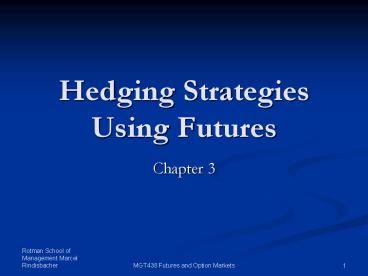Hedging Strategies Using Futures - PowerPoint PPT Presentation
1 / 17
Title:
Hedging Strategies Using Futures
Description:
A long futures hedge is appropriate when you know you will purchase an asset in ... The unsystematic risk that is unique to the stock is not hedged ... – PowerPoint PPT presentation
Number of Views:97
Avg rating:3.0/5.0
Title: Hedging Strategies Using Futures
1
Hedging Strategies Using Futures
- Chapter 3
2
Long Short Hedges
- A long futures hedge is appropriate when you know
you will purchase an asset in the future and want
to lock in the price - A short futures hedge is appropriate when you
know you will sell an asset in the future want
to lock in the price
3
Arguments in Favor of Hedging
- Companies should focus on the main business they
are in and take steps to minimize risks arising
from interest rates, exchange rates, and other
market variables
4
Arguments against Hedging
- Shareholders are usually well diversified and can
make their own hedging decisions - It may increase risk to hedge when competitors do
not - Explaining a situation where there is a loss on
the hedge and a gain on the underlying can be
difficult
5
Convergence of Futures to Spot(Hedge initiated
at time t1 and closed out at time t2)
Futures Price
Spot Price
Time
t1
t2
6
Basis Risk
- Basis is the difference between spot futures
- Basis risk arises because of the uncertainty
about the basis when the hedge is closed out
7
Long Hedge
- Suppose that
- F1 Initial Futures Price
- F2 Final Futures Price
- S2 Final Asset Price
- You hedge the future purchase of an asset by
entering into a long futures contract - Cost of AssetS2 (F2 F1) F1 Basis
8
Short Hedge
- Suppose that
- F1 Initial Futures Price
- F2 Final Futures Price
- S2 Final Asset Price
- You hedge the future sale of an asset by entering
into a short futures contract - Price RealizedS2 (F1 F2) F1 Basis
9
Choice of Contract
- Choose a delivery month that is as close as
possible to, but later than, the end of the life
of the hedge - When there is no futures contract on the asset
being hedged, choose the contract whose futures
price is most highly correlated with the asset
price. This is known as cross hedging.
10
Optimal Hedge Ratio
- Proportion of the exposure that should optimally
be hedged is - where
- sS is the standard deviation of DS, the change
in the spot price during the hedging period, - sF is the standard deviation of DF, the change
in the futures price during the hedging period - r is the coefficient of correlation between DS
and DF.
11
Hedging Using Index Futures(Page 63)
- To hedge the risk in a portfolio the number of
contracts that should be shorted is - where P is the value of the portfolio, b is its
beta, and A is the value of the assets underlying
one futures contract
12
Reasons for Hedging an Equity Portfolio
- Desire to be out of the market for a short period
of time. (Hedging may be cheaper than selling the
portfolio and buying it back.) - Desire to hedge systematic risk (Appropriate when
you feel that you have picked stocks that will
outpeform the market.)
13
Example
- Value of SP 500 is 1,000
- Value of Portfolio is 5 million
- Beta of portfolio is 1.5
- What position in futures contracts on the SP
500 is necessary to hedge the portfolio?
14
Changing Beta
- What position is necessary to reduce the beta of
the portfolio to 0.75? - What position is necessary to increase the beta
of the portfolio to 2.0?
15
Hedging Price of an Individual Stock
- Similar to hedging a portfolio
- Does not work as well because only the systematic
risk is hedged - The unsystematic risk that is unique to the stock
is not hedged
16
Why Hedge Equity Returns
- May want to be out of the market for a while.
Hedging avoids the costs of selling and
repurchasing the portfolio - Suppose stocks in your portfolio have an average
beta of 1.0, but you feel they have been chosen
well and will outperform the market in both good
and bad times. Hedging ensures that the return
you earn is the risk-free return plus the excess
return of your portfolio over the market.
17
Rolling The Hedge Forward (page 67-68)
- We can use a series of futures contracts to
increase the life of a hedge - Each time we switch from 1 futures contract to
another we incur a type of basis risk































